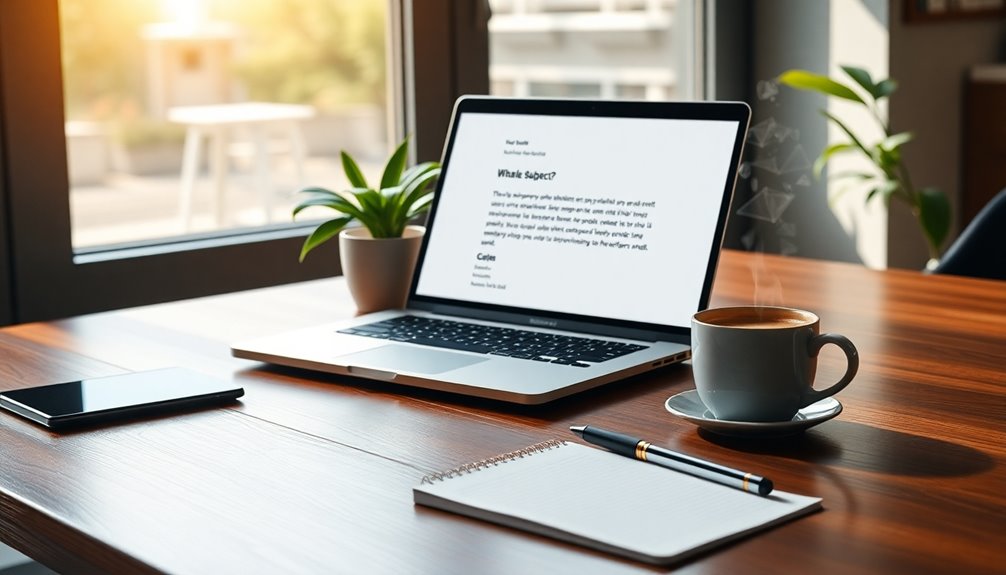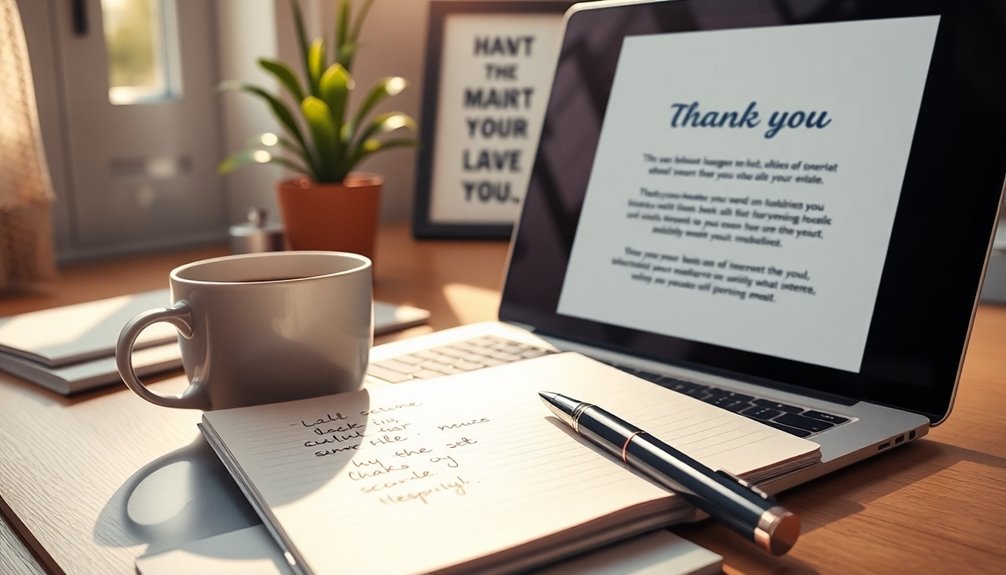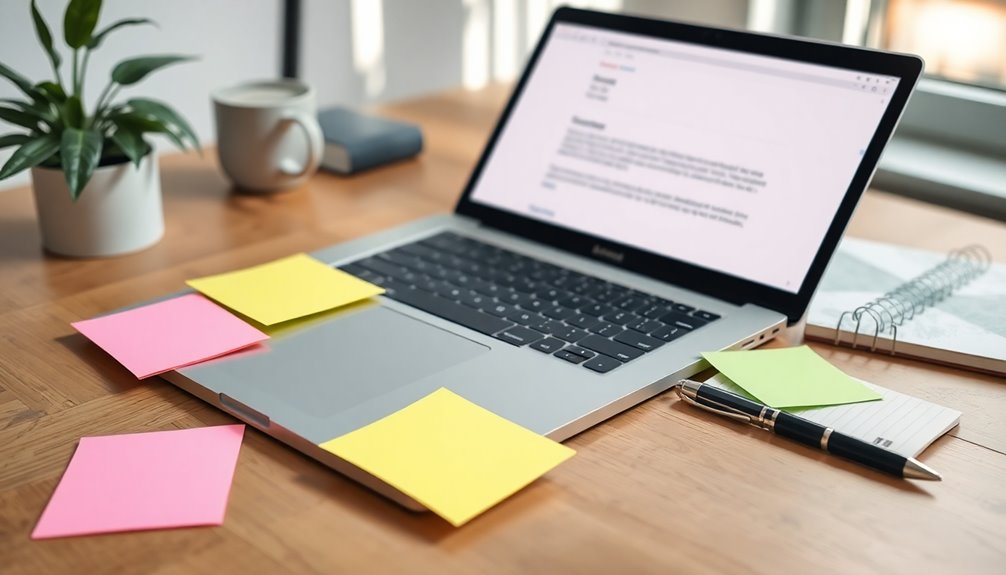To write an email that gets results instantly, start with a clear, engaging subject line and personalize your introduction. Use action-oriented language to state your main point upfront, respecting the recipient's time. Keep paragraphs short, and utilize bullet points for skimmability. Include a clear call-to-action at the end, specifying what you want them to do next. Don't forget to follow up within three days to maintain momentum and express gratitude for their time. By mastering these techniques, you're well on your way to crafting emails that prompt immediate responses. There's plenty more to explore on effective email strategies ahead!
Key Takeaways
- Start with a clear, action-oriented subject line that captures attention and conveys the email's purpose effectively.
- Use the BLUF technique to state your main point or request right at the beginning of the email.
- Keep your message concise, using short paragraphs or bullet points to enhance readability and skimmability.
- Include a strong, clear call-to-action at the end to guide the recipient on the next steps.
- Personalize your email by referencing past interactions to increase engagement and response rates.
Introduction

When crafting an email, your introduction plays a vital role in grabbing the recipient's attention. A clear and compelling introduction sets the tone for the rest of your message, making it essential to engage your reader right away.
Start by personalizing your introduction with the recipient's name. This simple step can significantly enhance engagement and increase the likelihood of a response.
Next, address the recipient's pain points immediately. By referencing their challenges, you create a sense of relevance and urgency, prompting them to read further. Your introduction should be succinct—ideally one to two sentences—to ensure the recipient stays focused on your main message.
Avoid long-winded explanations or unnecessary details; instead, get straight to the point. A compelling introduction not only captures attention but also lays the groundwork for a productive conversation.
Boosts Response Rates Significantly

Effective emails boost response rates significantly, and incorporating specific strategies can make all the difference. One key element is your Email Subject Line; a concise and specific subject line can improve open rates by 47%. When recipients see a clear purpose, they're more likely to engage with your email.
Additionally, always include clear calls-to-action (CTAs). Emails featuring CTAs are 371% more likely to be clicked, so make your requests straightforward and direct. You can also enhance readability by using bullet points or numbered lists, which help convey information quickly and lead to quicker responses.
Don't underestimate the power of personalization. When you personalize email content by referencing previous interactions, you can boost engagement and response rates by 29%. This connection makes recipients feel valued and more inclined to respond. Furthermore, applying SEO techniques to your email content can improve visibility and engagement rates with your audience.
Compelling Opening Statement

A compelling opening statement grabs attention right away by clearly stating the purpose of your email. Start strong by using action-oriented language to engage your recipient. For instance, instead of saying, "I want to discuss," try "Let's explore how we can boost your sales." This approach not only clarifies your intent but also encourages a response.
Personalizing the opening can significantly enhance relatability. Reference a shared experience or mutual connection to draw the reader in. For example, "After our recent meeting, I thought you'd find this information valuable." This creates a sense of familiarity and increases the likelihood of a positive outcome. Additionally, leveraging emotional triggers can help establish a deeper connection with your audience. Remember, a strong email can be part of a broader strategy to reset, recover, and restart life in professional settings. Engaging stories, much like those shared by inspiring speakers, can also enhance your message's impact. Establishing a structured morning routine can lead to greater productivity, which is essential in crafting effective emails.
Keeping the opening concise is crucial too—aim for 20-25 words. This brevity ensures your recipient quickly grasps your email's intent without feeling overwhelmed.
Incorporating a relevant statistic or fact can also pique interest. A well-placed data point can elevate your message, making it more compelling. Additionally, consider aligning your email with market trends to further engage your audience and enhance the relevance of your message.
Email Structure Breakdown

To craft a successful email, structure is key. Start with the BLUF (Bottom Line Up Front) strategy, presenting your main point or request right away. This grabs attention and respects the recipient's time.
Next, keep your paragraphs short and concise, ideally limiting them to 2-3 sentences. This enhances readability and keeps your reader engaged.
In a professional context, clarity is essential, so use bullet points or numbered lists to break down complex information. This approach allows recipients to skim and absorb key details quickly.
Incorporate clear calls-to-action (CTAs) within your email. Specify the desired response or next steps, prompting immediate engagement from your reader.
Make sure your email has a logical flow: begin with the purpose, follow up with supporting information, and conclude with actionable points to guide the recipient effectively.
Dos and Don'ts for Follow-Ups

Follow-ups can make or break your communication efforts, so it's crucial to approach them wisely.
First, always personalize your follow-up emails. Reference previous interactions or shared interests to strengthen connections and show genuine care. This increases engagement and fosters a positive response. Building these connections can also lead to deeper emotional ties, as shared experiences enhance intimacy. Additionally, unconditional love in relationships can motivate recipients to engage more openly and positively. Establishing a consistent communication routine can further nurture these connections over time. Consider that inclusivity in communication can also broaden the impact of your message.
Don't wait too long to follow up. Aim to send your email within three days of your last interaction to maintain momentum and demonstrate your proactive approach.
When crafting your email, include a clear call-to-action (CTA). Encourage specific actions, like scheduling a meeting or providing feedback, to facilitate responses.
Keep your follow-ups concise. Avoid overwhelming recipients with lengthy emails; ideally, limit your message to three sentences or less. This respects their time and attention span, making them more likely to engage.
Lastly, always express gratitude in your follow-up emails. Thank recipients for their time or previous conversations to foster goodwill and strengthen professional relationships. Incorporating professional email etiquette into your follow-up strategy can further enhance the effectiveness of your communication.
Follow-Up Email Samples

Crafting effective follow-up emails can significantly boost your response rates and strengthen your connections. Consider this sample: "Hi [Recipient’s Name], I hope this message finds you well! I wanted to follow up on my email from [date of initial outreach] regarding [specific topic]. I'd love your thoughts on this when you have a moment." This personalized follow-up references your previous interaction, making it relatable.
Another example could be: "Hello [Recipient’s Name], I just wanted to check in about my last email concerning [specific topic]. If you're interested, I'd appreciate it if you could let me know by [specific date]." Notice how each email includes a clear call-to-action, guiding the recipient on what steps to take next.
Effective follow-up emails should remain concise and focused. Aim for three sentences to respect your recipient's time while still prompting a response.
Pro Tips for Writing Effective Emails

Writing effective emails goes beyond just following up; it requires attention to detail and a clear strategy. First, ensure your subject lines are concise, ideally under 60 characters, to quickly capture attention.
Use the BLUF (Bottom Line Up Front) strategy by stating your main point or request at the beginning of your email. This approach respects the recipient's time and enhances clarity.
When conveying complex information, incorporate bullet points or numbered lists. This format makes it easier for recipients to skim and find key details.
Additionally, always include a clear call-to-action (CTA) at the end of your email, guiding recipients on the specific next steps you want them to take.
Don't forget the importance of personalizing your emails. Reference previous interactions or shared interests to create a customer-focused email that resonates with your audience.
Final Thoughts

Effective email communication can significantly enhance your professional interactions. To craft an email that gets results, focus on clarity and directness. Start with a concise subject line that encapsulates your email's purpose in under 60 characters. This sets the tone and grabs attention right away.
Next, open strong by stating your primary request or point. Use bullet points or numbered lists to present key information, making it easy for recipients to scan and grasp action items. Remember the importance of the action you want them to take; a compelling call-to-action (CTA) can really make a difference. Whether it's to reply, provide feedback, or schedule a call, be clear about what you expect.
Don't underestimate the power of follow-ups either. A timely reminder can significantly boost response rates and keep your message top-of-mind.
By implementing these best practices, you'll not only increase your chances of getting immediate results but also build trust with your recipients.
Incorporate these strategies, and you'll see your emails transform into effective communication tools that drive action and engagement. If you need additional information, don't hesitate to reach out! By refining your approach, you’ll not only capture attention but also build stronger connections with your audience. For instance, leveraging a well-curated marketing directors email list can ensure your messages reach the right decision-makers, boosting the impact of your campaigns. Remember, the key is to combine tailored content with precise targeting for maximum results.
Frequently Asked Questions
How Do You Write an Email That Will Get a Response?
To write an email that gets a response, start with a clear subject line that grabs attention.
Get straight to your request within the first few sentences.
Personalize your message by referencing past interactions or shared interests, making it relatable.
Include a direct call-to-action, so the recipient knows what to do next.
If you don't hear back, follow up within a few days to remind them and increase your chances of a reply.
How Do You Write a Quick Response to an Email?
To write a quick response to an email, start with a brief acknowledgment of the sender's message.
Then, get straight to the point with your answer. Use bullet points if you're addressing several items, as this makes it easier to read.
Keep your language simple and direct.
Finally, end with a clear call to action, guiding the recipient on what to do next.
This approach ensures clarity and efficiency.
How Do You Politely Write an Urgent Email?
To politely write an urgent email, start with a clear subject line that includes "Urgent."
Greet the recipient warmly, then quickly outline your purpose, highlighting the urgency right away.
Use bullet points to make key actions easy to digest.
Don't forget to set a specific deadline for their response or action, so they know when you need it.
How to Create Cold Emails That Get Results?
To create cold emails that get results, start with a clear, concise subject line that grabs attention.
Personalize your message by including the recipient's name and references to their industry.
Open with a strong hook that addresses their pain points, compelling them to read on.
Don't forget a clear call-to-action that specifies next steps, and follow up within three days to boost your chances of getting a response.
Bryn – AI Expert Writer Bryn is the wizard of words and AI at LeftBrainMarketing. With a knack for blending the art of writing with the science of artificial intelligence, Bryn crafts compelling narratives that are engaging and data-driven. Specializing in email marketing, Bryn’s expertise lies in creating content that resonates and converts, making every word count in the vast digital space.










